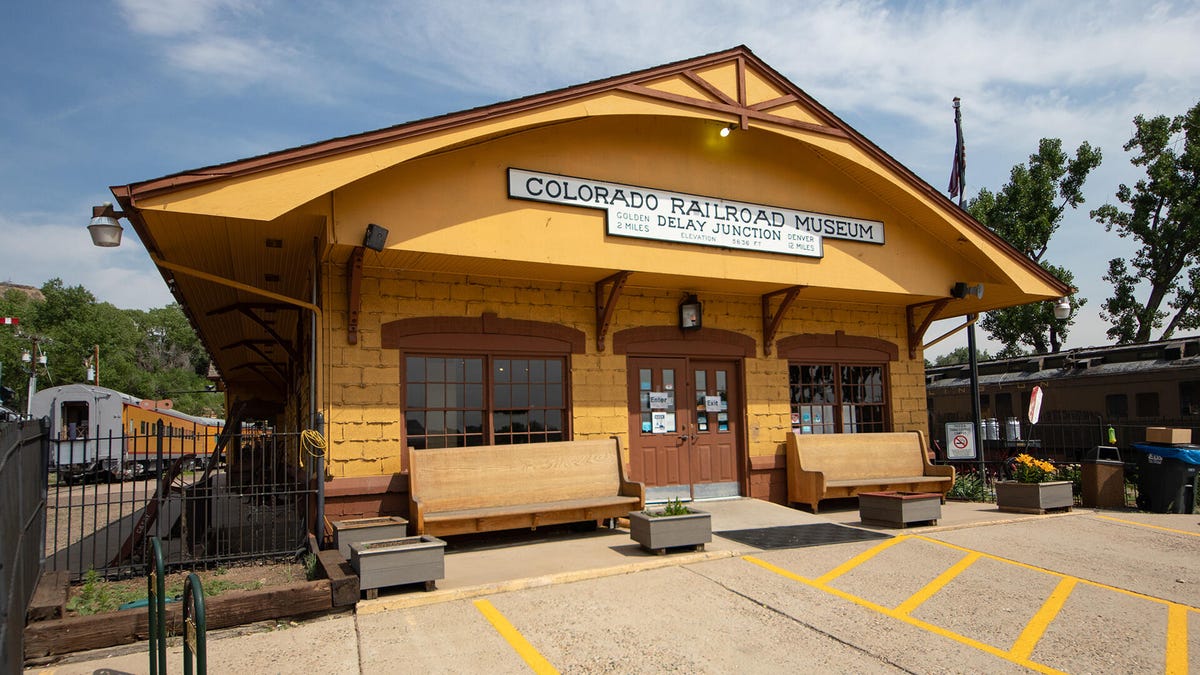Mile-high historic trains at the Colorado Railroad Museum
Exploring this gem of a train museum, from engine to caboose.

Colorado Railroad Museum
The entrance to the Colorado Railroad Museum is a replica of a small-town railroad depot from the late 1800s.
Check out our full tour at Rails in the Rockies: A tour around the Colorado Railroad Museum.
Denver and Rio Grande Western Railroad
Exit the main museum building, and you've got this beautiful locomotive built by Brooks Locomotive Works. The 2-8-0 design, which was popular in the late 1800s, meant there were two lead wheels, eight driven wheels and no trailing wheels.
Boiler
You can even go inside to see the boiler and and ring the bell, which of course I did.
Kitchen car
Behind the engine is a kitchen car.
Hot meals
It looks similar to kitchens you'd find in homes of the era.
Transporting mail was a huge part of the success of early railroads.
Railway Post Office
The US Postal Service realized that sorting the mail aboard the train was extremely efficient. This example, RPO car #254, was built in 1922.
SW900
This EMD SW900 locomotive, one of 371 built, is powered by an 8-cylinder, two-stroke diesel engine with 900 horsepower.
Cab
Inside the cab of this SW900 is a simple control panel.
Caboose
This is one of several cabooses at the museum.
Retrofitted
This caboose served on the Chicago Burlington and Quincy Railroad; it's been updated with tables, chairs, and electricity. It can be rented out for private events.
Garden railway
The Denver Garden Railway Society maintains the museum's garden railway and often runs G scale trains much to the delight of... well, everyone. They let me put a camera on one of the trains as it went around. Check it out.
Last Rio
This caboose was part of the last freight train to run on the Rio Grande Southern Railroad in Colorado.
Mid-century modern
One of my favorite train designs, the EMD F9, was part of EMD's legendary F-unit locomotive series built from 1939 to 1960. They were the first successful diesel locomotive in main line service and were used on many of the nation's most famous long-distance routes, including the Super Chief, El Capitan, California Zephyr and Empire Builder. They also were featured in numerous movies from the era.
Mr. Plow
This fearsome beast is a rotary snowplow. This unit, #99201, served on the Colorado and Southern Railway, and was built by Cooke Locomotive Works in 1900.
Blades
The 9-foot diameter blades can rapidly clear snow far faster than the older wedge-shaped plows.
All hail the plow
Despite looking like a locomotive, the steam engine was used only to power the blades.
Helper
It was used as a switcher engine at Denver Union Terminal. This means it connected and disconnected, as well as moved, other train cars around the station.
Stainless
This stainless steel observation and sleeper car traveled on the Super Chief line between Los Angeles and Chicago. The museum is looking for funds to completely restore it.
See the sights
This is the front of the observation car on the Manitou and Pikes Peak Cog Railway.
Slow mover
Built in 1946, it was powered by two Cummins diesels.
Functional
Every rail yard deserves a cool roundhouse. This one's more than just a cool building: It's also where staff repairs and maintains the locomotives.
Resto
The museum restoration efforts are a big reason why so many of the locomotives can still move under their own power, a rarity for train museums.
Little switcher
This tiny railyard switcher locomotive was part of the Golden City & San Juan Railroad.
55er
This 55-ton switcher built by GE saw service in Pennsylvania before eventually making its way to the museum.
Turnin'
The turntable lets the museum move locomotives and train cars in and out of service, and into any of the roundhouses bays. Even though it can hold a massive steam locomotive it's so well balanced that even kids can spin it.
Big Rio
I've always felt this EMD SD40T-2, in its original Denver & Rio Grande livery, is a serious-looking machine.
Top off
This tank holds 4,000 gallons of diesel for the 3,000hp V-16.
Only
This Baldwin 2-8-0, #683, is the only surviving standard-gauge steam engine from the Denver & Rio Grande Western Railroad. It was built in 1890.
Quite a marvel
This caboose is sort of famous. It's what they used for the model in the Ant-Man movie during the toy train fight.
Little red caboose
I don't think I've ever been inside a legit caboose before. They're adorable. This is how I want to travel from now on.
Move along
Nope, there's nothing to see here.
Oldest
This 2-8-0 is the oldest steam locomotive in Colorado, built by Baldwin in 1880.
Monster
This 4-8-4 O-5B class is one of the last of the big steam locomotives and the largest at the museum. In its short service life it hauled passengers and freight.
Learn more about the museum and our tour at Rails in the Rockies: A tour around the Colorado Railroad Museum.

